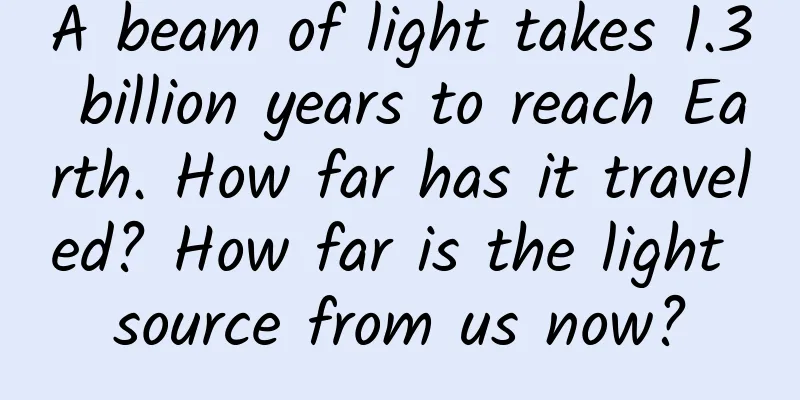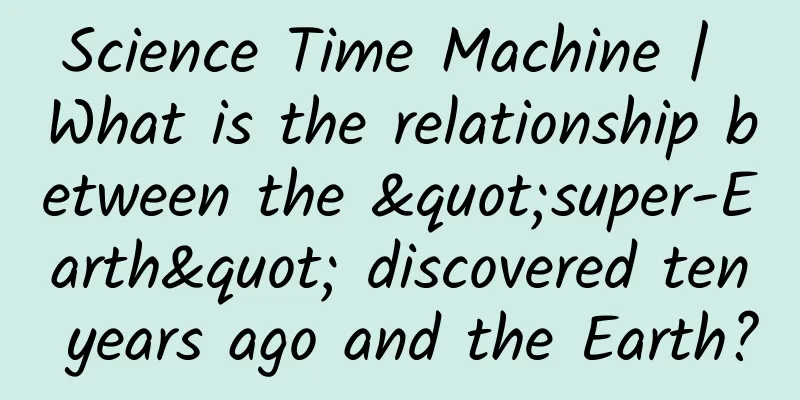A beam of light takes 1.3 billion years to reach Earth. How far has it traveled? How far is the light source from us now?

|
This article is based on answering a question from netizens: Suppose a beam of light is emitted to the earth from a certain point in the universe, and this beam of light takes 1.3 billion years to reach the earth. How many kilometers is this point away from the earth? This is a simple math problem, but to answer it, you must first understand the definition of a light year. Light Years 1 light year is the length of time that light takes to travel in one year. The exact value of the speed of light in a vacuum is 299792458 m/s (meters per second), and is generally measured at about 300,000 km (kilometers) per second. In the measurement of the universe, the Julian year is used. There are 356.25 days in a year, 24 hours in a day, 3600 seconds in an hour, and 31557600 seconds in a year. So 1 light year is the distance that light takes 31557600 seconds, and the exact value is 9460730472580800m. Generally, 1 light year is about 9.46 trillion km. This is the origin of light years. The light took 1.3 billion years to reach the Earth, which means that the light source is 1.3 billion light years away from the Earth. That is, at the moment it emitted light, it was about 122,980 trillion kilometers away from us. But since it took 1.3 billion years for this beam of light to reach our Earth, the location of this beam of light when it was emitted is also the location 1.3 billion years ago. However, the universe is constantly expanding, and distant galaxies are moving away from us at high speeds. After 1.3 billion years of movement, this light source (or galaxy) is no longer in that location. So how far is this light source from us now? This is where Hubble's law comes into play. Hubble's Law Hubble's Law is a theory for calculating the rate at which objects at different distances are moving away from us, or the rate at which the universe is expanding. It was discovered and established by the great astronomer Edwin Hubble in the last century. After long-term observation of the universe, Hubble discovered the law of cosmic expansion: all distant celestial bodies are moving away from us, and are isotropic, the farther away, the faster, and in a linear relationship. This means that no matter from which direction you look, all distant galaxies at the same distance are moving away from us at the same speed, the farther away, the faster the speed, and the increase in speed is proportional to the distance. In this way, he derived a law of cosmic expansion, which is called Hubble's law, which can be simply expressed as: V=HD. Here V represents the speed at which distant galaxies are moving away from us, in km/s (kilometers per second); H represents the Hubble constant, in (km/s)/Mpc (million parsecs, about 3.26 million light years); and D represents the distance of the observed galaxy, in Mpc. From this formula, as long as we know how far away the light source (galaxy) is from us and know the Hubble constant, we can calculate the speed at which it is moving away from us. In other words, the speed at which a galaxy at a certain distance is moving away from us is the rate at which the universe is expanding. There are many ways to measure the distance of distant galaxies from us, such as spectral redshift, standard candles, Cepheid variables, trigonometric parallax, etc. Many of them have been introduced in the past, so I won’t talk about them today. Under the premise of knowing the distance of celestial bodies, the Hubble constant is a key in the Hubble law formula. As long as we know the Hubble constant, we can know the speed at which galaxies at different distances are moving away from us. Hubble constant What is the Hubble constant? It is the speed at which galaxies are moving away from us at a distance of Mpc (million parsecs, about 3.26 million light years). We know that the speed at which distant galaxies are moving away from us is isotropic, and the farther away, the faster, in a linearly proportional relationship. With the Hubble constant, this point speed, we can calculate the expansion rate of the universe at different distances. Here, let me explain in particular why the Hubble constant is expressed in such a large unit, which is about 3.26 million light years per million parsec. This is because the expansion of the universe is a large-scale expansion. At a smaller distance scale, the movement of celestial bodies is more constrained by gravity, and the expansion of the universe cannot be manifested. For example, the Andromeda Galaxy is about 2.54 million light-years away from our Milky Way. Currently, under the influence of each other's gravity, the two galaxies are not separated, but are showing a trend of moving closer, with a speed of 300km/s. It is estimated that in 3 to 4 billion years, the two galaxies will collide and then merge into a larger galaxy. But at distances farther than the Hubble constant, galaxies are generally moving away from us. For decades, astronomers have been measuring the Hubble constant using various methods, such as the standard candle method of supernovae, gravitational lensing, the Planck satellite and the Chandra X-ray Observatory. The measured Hubble constants are also different, but they are roughly within the same range. In 2013, the European Space Agency used the Planck satellite to measure the Hubble constant as 67.8, which is the smallest Hubble constant to date; in 2019, German scientists calculated the Hubble constant using the gravitational lens effect and found it to be 82.4, which is the largest Hubble constant to date. These two data are the most cited data in the scientific community. We neither follow the larger nor the smaller data, but take an average value in between, and get the Hubble constant to be 75.1. The current distance between us and the light source is 1.3 billion light years We put the Hubble constant 75.1 obtained above into the Hubble law formula, and we can calculate that the speed at which the light source (or galaxy) is moving away from us at a distance of 1.3 billion light years is about 30,000 km/s. If 1.3 billion years pass at this speed, the light source or galaxy will move away from us by about 122,860 trillion kilometers, or about 130 million light years, based on the distance of 1.3 billion light years. In this way, when the light emitted from a distance of 1.3 billion light-years from us reaches our Earth, the light source or galaxy is no longer in its original position, but is already farther away than 1.43 billion light-years. Why is it farther? Because the distance between distant galaxies and us should be calculated according to the co-progressive distance formula as time goes by, that is, the speed is calculated progressively with each further distance. This formula is very complicated and involves complex theories such as calculus and space-time metric. As a popular science article, I will not make it so complicated here, just a simple calculation. This simple calculation means that at 1.3 billion light years away, the galaxy is moving away from us at a rate of about 30,000 km/s due to the expansion of the universe; and at 1.43 billion light years away, the expansion rate of the universe is about 33,000 km/s. By compromise, the expansion rate is 31,500 km/s. After 1.3 billion years of movement, the distance has increased by about 137 million light years, so now the light source is at a position of 1.437 billion light years away. The source of the gravitational waves transmitted from 1.3 billion light years away can also be understood in this way In 2015, humans detected the first gravitational wave using a precision gravitational wave detector. This gravitational wave was a ripple in space and time caused by the collision of two black holes 1.3 billion light-years away, and it took 1.3 billion years to reach Earth. Science has proven that the transmission speed of gravitational waves is the speed of light. Therefore, we can use the above calculation method to calculate that the larger black hole formed by the merger of two black holes is actually 1.437 billion light-years away from us. I think you can understand what I said, right? Welcome to discuss, thank you for reading. The copyright of Space-Time Communication is original. Infringement and plagiarism are unethical behavior. Please understand and cooperate. |
<<: Beibei! This is the dinosaur with the cutest name you've ever seen...
>>: Still picking your nose? Let's see what happens to your nose if you pick your nose frequently...
Recommend
How to make the next match-3 game?
[[140846]] Mobile games have entered a white-hot ...
Introduction to Wang Guozhen: How does Chongqing website optimization improve user experience?
SEOers all know that the user experience of a web...
Design your APP interface like a designer
[[140382]] In early 2014, the number of people us...
The “User Cultivation” Model on the Internet (I)
Have you ever thought that you are being "cu...
Ice and fire, Kilimanjaro on the equator is a snowy mountain and also a volcano!
Review expert: Researcher Xu Jiandong, Director o...
Steps to set up a bidding account. How do newbies in Baidu bidding SEM set up an account?
Speaking of bidding promotion, many people will d...
Why do some people hate cilantro, while others love it? Here's the reason!
Coriander is very familiar to everyone. As a plan...
On the development of "Android" in the next ten years
Electronic products, especially the mobile phone ...
Kunming Hun Tea Tasting 2022 exclusive Hun Sang experience is waiting for you!
Kunming Hun Tea Tasting 2021 Exclusive Hun Sang E...
2 plums equal 1 gram of salt. It turns out there is so much "invisible salt" in our lives!
Audit expert: Wang Guoyi Postdoctoral fellow in N...
iOS market share rises by the end of 2022, Android slightly down
iOS's market share has risen in the last quar...
How much does it cost to open a Douyin enterprise account? What are the operating methods?
This article mainly introduces how much money is ...
Bidding promotion: 6 secrets to high conversion!
A few days ago, someone chatted with me and said:...
When will Qingming Festival fall on April 5, 2022? What is the exact time in minutes and seconds? Attach details
Recently, many provinces and cities in my country...
AMD abandons old users, Ryzen processors will no longer support Windows 7
Intel's new Kaby Lake (7th generation Core) a...









